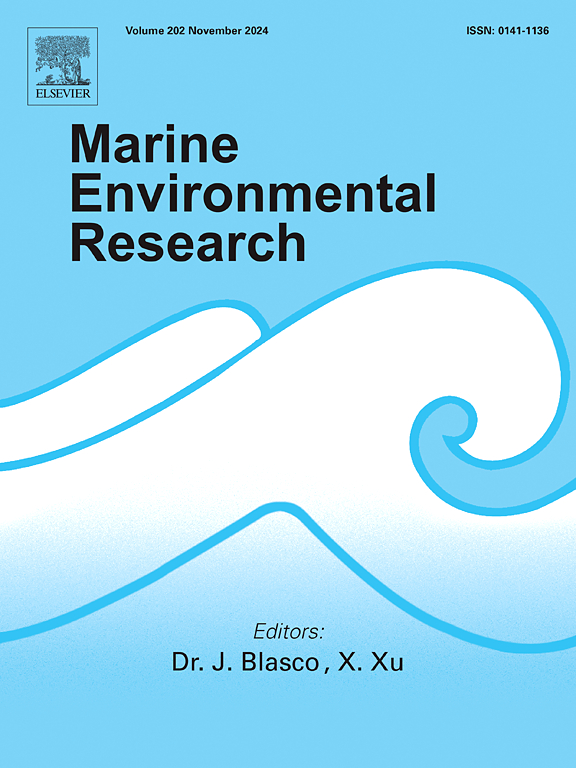Functional specialization of the eelgrass rhizosphere microbiome: Root exudate-mediated assembly and implications for degraded meadow rehabilitation
IF 3.2
3区 环境科学与生态学
Q2 ENVIRONMENTAL SCIENCES
引用次数: 0
Abstract
Seagrass meadows provide vital coastal ecosystem services but face accelerated degradation due to anthropogenic stressors. While rhizosphere microbes are recognized for enhancing nutrient cycling and supporting meadow resilience, the mechanisms by which seagrasses recruit functional groups critical for stress mitigation from bulk sediment via root exudates remain poorly understood. This study employed metagenomics and metabolomics to characterize Zostera marina root exudates and compare microbial (bacterial, fungal, archaeal) composition, diversity, and metabolic functions between bulk sediment and rhizosphere. We demonstrate that root exudates--enriched in organic acids and phenolic compounds--act as ecological filters, selectively enriching rhizosphere taxa with specialized functions relevant to habitat recovery, such as nitrogen/sulfur cycling (key processes for mitigating eutrophication impacts). Rhizosphere communities exhibited reduced diversity but heightened functional specialization aligned with host nutrition and stress tolerance, contrasting sharply with bulk sediment communities dominated by methane production and carbon degradation pathways. Critically, bulk sediment serves as a reservoir of pre-adapted genetic potential for environmental adaptation, supplying niche-adaptive genes to the rhizosphere microbiome. Strong metabolite-microbe correlations confirm host exudates as primary drivers of microbial assembly, synchronizing functional traits with host demands. These findings elucidate host-mediated recruitment strategies underpinning seagrass resilience and provide mechanistic insights for designing microbiome-assisted rehabilitation of degraded seagrass habitats. (Images were created with BioRender).

大叶草根际微生物群的功能特化:根分泌物介导的组装及其对退化草甸恢复的影响
海草草甸提供重要的沿海生态系统服务,但由于人为压力而面临加速退化。虽然根际微生物被认为可以促进养分循环和支持草甸的恢复力,但海草通过根渗出物从大量沉积物中吸收对缓解压力至关重要的官能团的机制仍然知之甚少。本研究采用宏基因组学和代谢组学方法对小藻根分泌物进行了表征,并比较了块状沉积物和根际微生物(细菌、真菌、古细菌)的组成、多样性和代谢功能。研究表明,富含有机酸和酚类化合物的根分泌物可以作为生态过滤器,选择性地丰富根际分类群,这些分类群具有与栖息地恢复相关的特殊功能,如氮/硫循环(减轻富营养化影响的关键过程)。根际群落多样性降低,但与寄主营养和胁迫耐受性相关的功能专门化程度提高,与以甲烷生产和碳降解途径为主的块状沉积物群落形成鲜明对比。至关重要的是,大块沉积物作为环境适应的预适应遗传潜力的储存库,为根际微生物群提供生态位适应基因。强烈的代谢物-微生物相关性证实了宿主分泌物是微生物组装的主要驱动因素,使功能性状与宿主需求同步。这些发现阐明了支持海草恢复力的宿主介导的招募策略,并为设计微生物群落辅助的退化海草栖息地恢复提供了机制见解。(图像是用BioRender创建的)。
本文章由计算机程序翻译,如有差异,请以英文原文为准。
求助全文
约1分钟内获得全文
求助全文
来源期刊

Marine environmental research
环境科学-毒理学
CiteScore
5.90
自引率
3.00%
发文量
217
审稿时长
46 days
期刊介绍:
Marine Environmental Research publishes original research papers on chemical, physical, and biological interactions in the oceans and coastal waters. The journal serves as a forum for new information on biology, chemistry, and toxicology and syntheses that advance understanding of marine environmental processes.
Submission of multidisciplinary studies is encouraged. Studies that utilize experimental approaches to clarify the roles of anthropogenic and natural causes of changes in marine ecosystems are especially welcome, as are those studies that represent new developments of a theoretical or conceptual aspect of marine science. All papers published in this journal are reviewed by qualified peers prior to acceptance and publication. Examples of topics considered to be appropriate for the journal include, but are not limited to, the following:
– The extent, persistence, and consequences of change and the recovery from such change in natural marine systems
– The biochemical, physiological, and ecological consequences of contaminants to marine organisms and ecosystems
– The biogeochemistry of naturally occurring and anthropogenic substances
– Models that describe and predict the above processes
– Monitoring studies, to the extent that their results provide new information on functional processes
– Methodological papers describing improved quantitative techniques for the marine sciences.
 求助内容:
求助内容: 应助结果提醒方式:
应助结果提醒方式:


